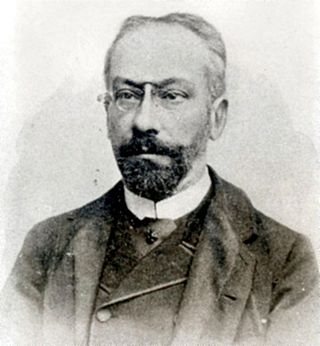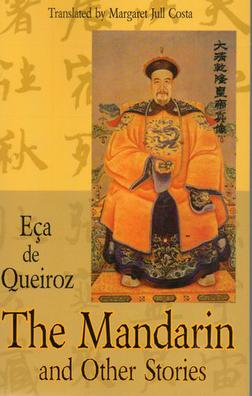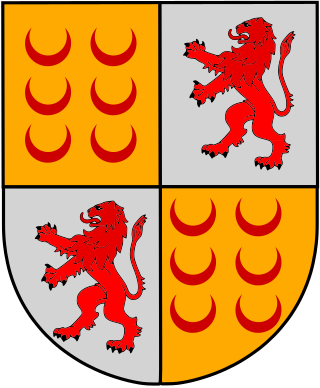
Francisco Teixeira de Queiroz (May 3, 1848 - July 22, 1919), who used the pen name of Bento Moreno, was a Portuguese writer. [1]

Francisco Teixeira de Queiroz (May 3, 1848 - July 22, 1919), who used the pen name of Bento Moreno, was a Portuguese writer. [1]
Francisco Teixeira de Queiroz was born in 1848 to José Maria Teixeira de Queiroz and Antónia Joaquina Pereira Machado, in Arcos de Valdevez, a small town at the northern tip of Portugal. He graduated in medicine from the University of Coimbra.
He was a vereador (alderman) in Lisbon around 1885 and a deputy in the legislature in 1893. He joined the Constituent Cortes in 1911 as a deputy for the circle of Aldeia Galega (now the city of Montijo), and resigned the position in the same year. He additionally served as Minister of Foreign Affairs in the first government headed by José de Castro in 1915. During that same year, he was also president of the Academy of Sciences of Lisbon.
He was married to Teresa Narcisa de Oliveira David, and had six children.
Teixeira de Queiroz died in Sintra in 1919.
As a novelist and short story writer, he was a faithful follower of the naturalist and realist schools prevalent at the time.
At the very outset of his literary career, while he was still a student, he initiated two parallel series of short stories and novels. These were titled Rural Comedy and Bourgeois Comedy, and are considered his most significant works. His choice of this model was inspired by Balzac, whose influence is also evident in the series' content and their predominantly realist and naturalist style.
Antonio Jose Saraiva and Oscar Lopes, in their History of Portuguese Literature, compared his talent to that of José Maria de Eça de Queiroz, widely considered one of the greatest Portuguese writers.
Rural Comedy series
Bourgeois Comedy series
Outside of these two series, Teixeira de Queiroz also published:

José Maria de Eça de Queiroz or Queirós is generally considered to have been the greatest Portuguese writer in the realist style. Zola considered him to be far greater than Flaubert. In the London Observer, Jonathan Keates ranked him alongside Dickens, Balzac and Tolstoy.

Manuel Teixeira Gomes, GCSE was a Portuguese politician and writer. He served as the seventh president of Portugal between 5 October 1923 and 11 December 1925.

Camilo Castelo Branco, 1st Viscount of Correia Botelho, was a prolific Portuguese writer of the 19th century, having produced over 260 books. His writing is considered original in that it combines the dramatic and sentimental spirit of Romanticism with a highly personal combination of sarcasm, bitterness and dark humour. He is also celebrated for his peculiar wit and anecdotal character, as well as for his turbulent life.

José Eduardo Agualusa Alves da Cunha is an Angolan journalist and writer of Portuguese and Brazilian descent. He studied agronomy and silviculture in Lisbon, Portugal. Currently he resides in the Island of Mozambique, working as a writer and journalist. He also has been working to establish a public library on the island.

Columbano Bordalo Pinheiro, who is usually referred to as Columbano, was a Portuguese Realist painter. Usually considered the greatest Portuguese painter of the 19th century, he has been compared to the likes of Wilhelm Leibl and John Singer Sargent.

José Duarte Ramalho Ortigão was a Portuguese writer of the late 19th century and early 20th century.

António Botto was a Portuguese aesthete and lyricist poet.
The Goan writer José da Silva Coelho was the author of several dozen pieces of wickedly satirical short fiction in the 1920s and 1930s, published for the most part in the Portuguese-language newspaper O Heraldo. He is 'easily the most prolific Goan fictionist in Portuguese'.

António José Enes, commonly known as António Enes, was a Portuguese politician and writer.
Queiroz is a Portuguese surname. It may refer to:

The Literature of Cape Verde is among the most important in West Africa, it is the second richest in West Africa after Mali and modern day Mauritania. It is also the richest in the Lusophone portion of Africa. Most works are written in Portuguese, but there are also works in Capeveredean Creole, French and notably English.

The Mandarin is a novella on the sin of avarice by José Maria de Eça de Queirós, also known as Eça de Queiroz. It was first published in Portuguese in 1880. The first English version, translated by Richard Franko Goldman, was published by The Bodley Head in 1965. A translation by Margaret Jull Costa, was published by Dedalus Books in 1993. A revised version was published by Dedalus in 2009, together with three short stories.
Alto de São João Cemetery is the largest cemetery in Lisbon, Portugal, located in the freguesia of Penha de França, in eastern Lisbon.

The House of Queiroz is an aristocratic and noble family of Portugal. The Queiroz family is one of the 72 houses of the Portuguese high nobility, displayed at the Palace of Sintra(Portuguese: Palácio de Sintra) in the Sala de Sintra(English: Sintra's Room). The room was created by the King Dom Manuel I to organize the coat or arms of the most important families in the Portuguese nobility.

António Maria Vasco de Melo Silva César e Meneses was a Portuguese noble who was the 9th Count of Sabugosa. A law graduate, diplomat and high official, he was also a distinguished poet and writer of short stories, histories, comedies and poems. He was a member of the Life's Vanquished, an informal group of Portuguese intellectuals in the last three decades of the 19th century.